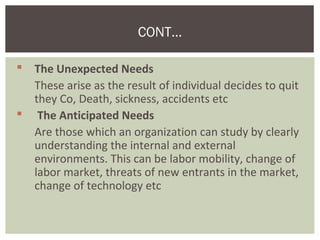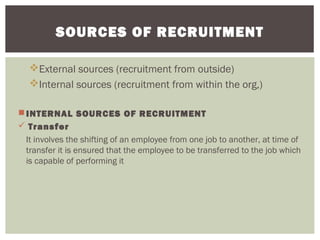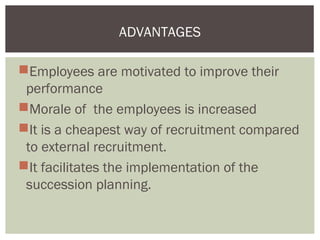Managing staff recruitment and selection
- 1. MANAGING STAFF RECRUITMENT AND SELECTION Prepared by Willy madinda Tutorial Assistant (T.A) Tanzania Public Service College +255714 367 2121 willy2002tz@yahoo.com
- 2. GENERAL OVERVIEW In the life of an organization, there is existence of numbers of retirements, deaths, transfer, demotions and turnover; all of these together with growth of the organization, need new employees for meeting the business requirements of the organization
- 3. CONT… Whatever the nature of the organization, the effectiveness of its operations and functions inevitably depends very largely upon the staff it employs (recruits and selects) Mullins (2005)
- 4. RECRUITMENT Definition It is the process of attracting appropriately qualified candidates to the organization in a cost effective manner Armstrong (2001) It identifies potential employees and create pool of candidates from which the skilled, and knowledgeable personnel could be selected
- 5. CONT… Recruitment is the process of identifying the sources of potential candidates for actual or anticipated organizational vacancies. Gupta (2006) Tony (2003) defines recruitment into widest term to mean the process of attracting, selecting and placing employees in vacant positions.
- 6. AIM OF RECRUITMENT To create the pool of application from which selection can be done. To create positive image of the Co among those who come in contact with it. To ensure that organization has right kind of people. To ensure that the Co’s HRs needs are met by attracting the right type of potential employee in a cost effective and timely manner.
- 7. RECRUITMENT NEEDS These refer to the circumstances which necessitate recruitments process to take place which in most case fall into the three categories namely Planned Needs Those arising form firm’s planning, decisions, and policy
- 8. CONT… The Unexpected Needs These arise as the result of individual decides to quit they Co, Death, sickness, accidents etc The Anticipated Needs Are those which an organization can study by clearly understanding the internal and external environments. This can be labor mobility, change of labor market, threats of new entrants in the market, change of technology etc
- 9. NOTE: For achieving an effective hiring procedure answer must be sought to the following questions: What are the requirements of the jobs to be filled? What kinds of and how many persons are needed? What source of recruitment will be utilized to select the right types of candidate for employment
- 10. SOURCES OF RECRUITMENT External sources (recruitment from outside) Internal sources (recruitment from within the org,) INTERNAL SOURCES OF RECRUITMENT Transfer It involves the shifting of an employee from one job to another, at time of transfer it is ensured that the employee to be transferred to the job which is capable of performing it
- 11. CONT… Promotion. This leads to shifting an employee to a higher position carrying higher responsibilities, facilities, status and pay. Retired and retrenched employees Here the retired and retrenched employees of the Co are encouraged to return if deemed appropriate
- 12. WHAT WOULD BE THE MERITS TO THE ORGANISATION FOR USING THIS TYPE OF RECRUITMENT?
- 13. ADVANTAGES Employees are motivated to improve their performance Morale of the employees is increased It is a cheapest way of recruitment compared to external recruitment. It facilitates the implementation of the succession planning.
- 14. DISADVANTAGES When vacancies are filled through internal promotions the scope for fresh talents is reduced. The employees may become lethargic if they are sure of time bound promotions The spirit of competition among the employees may be hampered Frequent transfers may reduce the overall productivity of the organization
- 15. EXTERNAL SOURCES OF EMPLOYMENT Mostly is used by new organizations. They have to tap external sources for various job positions. Sometime the established organizations have also to recruits employees from outside to fill positions whose specifications cannot be met by the present employees.
- 16. CONT… Educational Institutions. Consequently, many big organizations maintain a close liaison with the universities, vocational institutes and management institutes for recruitment to various jobs. Employment Agencies. Employment exchanges run by the Government are regarded as a good source of recruitment for unskilled and skilled personnel. They collect Detailed CV, s for personnel and later call for interview is arranged.
- 17. CONT… Recommendations. Applicants introduced by friends and relatives may prove to be good source of recruitment. Many employers prefer to take much persons because something about their background is known Direct Employment/Recruitment at Factory Gate. It is the process of placing a notice on the notice board of the enterprise specifying the details of the jobs available.
- 18. ADVANTAGES Whenever there is a rush of work or a large number of workers are absent this source of recruitment may be easily used. It gives chance for all kind of applicants to participate e.g., fresh from schools and those who have long time experience in different jobs. Unlike internal recruitment this has no tendency of reducing productivity of the organization because no any transfers conducted
- 19. DISADVANTAGES It ignores the implementation of succession planning It is cost full to conduct this kind of recruitment, e.g. Advertisements, Interviews, Allowances, time consuming It does not consider the competence and performance of the personnel employed; his or her ability to work will be proved when already employed.
- 20. THE NECESSARY STEPS FOR RECRUITMENT Job Analysis Attracting candidates Analysis of all applications Short listing Call for interview Selection process. Medical Examination Appointment letter and Placement
- 21. SELECTION Selection defined Is the choosing up the most suitable people, who have been attracted by the recruitment process, to work in the organization. Aim of selection To identify, from those coming forward from the recruitment process, the Individuals most likely to meet the needs of the organization (Palmer, 2008)
- 22. EMPLOYMENT TESTS Occupational test; it tests one with respect to job advertised Intelligence test; judges mental capacity Aptitude test; measures one capacity and growth potential Personality test; it tests applicants in an area of interest and mood.
- 23. FACTORS AFFECTING RECRUITMENT Internal factors The demand and supply of specific skill in the labor mkt. Political leaders - Provide the political issues, rules and policy which regulates Co’s. It may have preference to particular people like indigenous over foreigners The company image if good or bad affects the attractiveness to the job seekers Unemployment rate in the given area is high.
- 24. CONT… Internal factors 1.Co’s recruitment policy 2.Size of an organization 3.Costs of recruitment i.e. if evaluated to be high or low 4.The rate of growth of an organization
- 25. THANK YOU FOR LISTENING

























